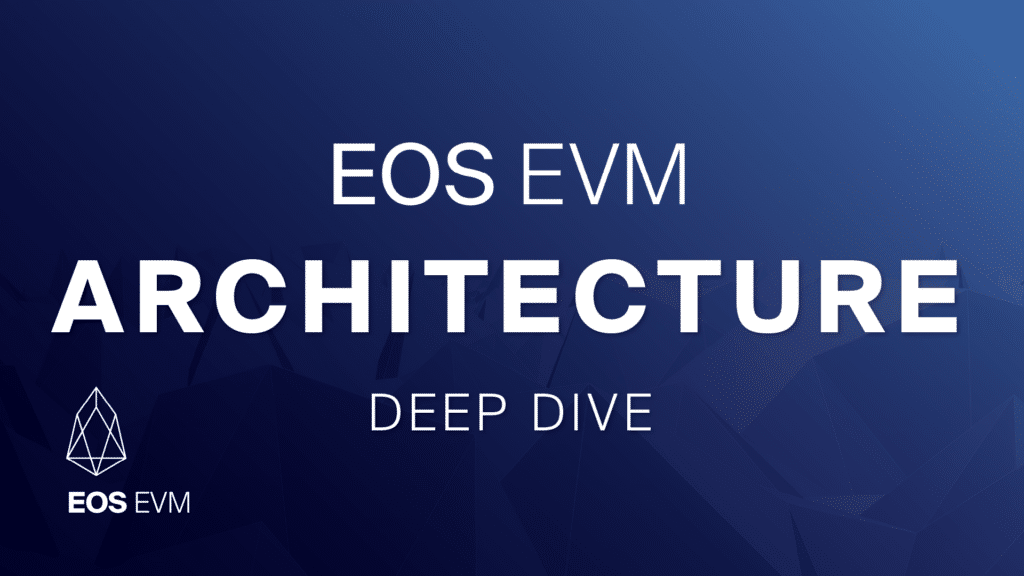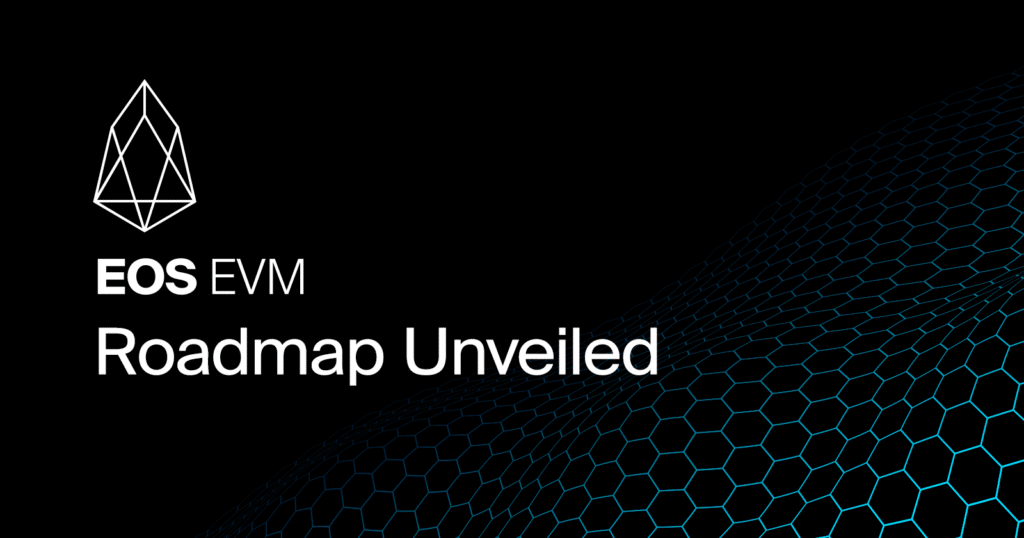EOS Network Foundation (ENF) engineers are consistently pushing the envelope in the areas of performance and interoperability, and today we highlight these efforts with an overview of the forthcoming October 16th launch of EOS EVM v0.6.0!
This update not only brings significant technical enhancements to the underlying infrastructure of the EVM, but a fresh suite of features are being introduced to advance the ecosystem’s DeFi capabilities. Perhaps the most highly anticipated element of this release is the ability for users to bridge USDT from the EOS Native layer to the EOS EVM in a completely trustless manner.
Innovating DeFi on EOS EVM With Trustless USDT Bridging
This release will mark a key milestone in the EOS ecosystem’s journey, as seamless interaction between EOS Native and EOS EVM is enabled.
EOS EVM v0.6.0 enhances the trustless bridge’s functionalities while keeping the platform fully EVM-compatible. Previously, only EOS could traverse the trustless bridge, however the upgrade to EOS EVM 0.6.0 will widen the horizon to the EOS Native version of USDT, which will be represented by an ERC-20 Token on the EOS EVM.
Given USDT’s significance in DeFi, this development is poised to amplify the Total Value Locked (TVL) along with liquidity on both native EOS and the EOS EVM. Although this new feature is currently limited to the USDT and EOS, future upgrades envision incorporating more EOS Native tokens.
Stablecoins, like USDT, are indispensable in the DeFi space and offer a range of benefits including:
- Reduced Volatility: Stablecoins promise consistent value. This consistency offers a dependable medium for transactions and preserving value within DeFi protocols.
- Liquidity in Trading Pairs: Serving as the backbone of many decentralized exchanges (DEXs) and DeFi platforms, stablecoins ensure efficient and liquid trading avenues.
- Risk Management: In fluctuating market scenarios, traders leverage stablecoins to safeguard their positions.
- Facilitation of DeFi Protocols: For DeFi lending/borrowing protocols, stablecoins are the preferred collateral. They provide users a way to gain interest or procure loans against their holdings.
- Decentralized Remittances: With their value stability, stablecoins are the go-to for cross-border transactions on DeFi platforms.
- Yield Farming Stability: Stablecoins are preferred for liquidity in yield farming, leading to steady returns and thus, greater participation.
- Simplified Onboarding: Newbies in the DeFi world find stablecoins an uncomplicated starting point.
Cross Virtual Machine Communication
This release adds two new mechanisms which provide the foundation necessary to expand the Trustless Bridge far beyond its initial capabilities:
Call action
The EOS EVM Contract now has a new action named “call” that allows any contract on EOS Native to call a function on EOS EVM.
Bridge messages
A new feature called “bridge messages” has been introduced, allowing strictly validated messages to pass between EOS EVM and the EOS Native, which gives EOS EVM the ability to call functions on native.
The release of EOS EVM Bridge Contracts demonstrates how these mechanisms can be used to enable other tokens on EOS such as USDT to be moved across the Trustless Bridge to the EOS EVM side and then back to the EOS Native side, but they open the door for unlocking a great deal more.
With these new features in place we are witnessing the advent of what has been described as “cross machine virtual communication”. The EOS EVM, being a blockchain virtualization on EOS, can now begin to utilize EOS Native multisig capabilities, and more. This is a truly unprecedented development that creates a best of both worlds scenario.
Combined, these mechanisms create the potential for highly novel use-cases to emerge between EOS Native & EVM including:
- ERC-20 token bridge.
- Cross-chain trading.
- Cross-chain oracles.
- Native + EVM DEX aggregator.
- Native MSIG to EVM.
- NFT bridge (AtomicAssets <=> ERC721).
- Cross VM arbitrage between DeFi dApps.
- Offloading heavy computation to EOS Native from EVM.
- Aggregating liquidity across virtual machines.
Members of the EOS developer community are already exploring potential implementations of these use-cases. It will be exciting to see how the various teams building on both EOS Native and EOS EVM use their newfound powers.
A Look Under the Hood of EOS EVM v0.6.0
To realize the above advancements, EOS EVM underwent a series of intricate technical adjustments that are covered in more depth within their respective github repos linked to below.
- The Trustless Bridge Frontend introduces the ability to seamlessly transfer USDT (EOS) tokens between the EOS Native environment and the EOS EVM environment using a simple user interface.
- The EOS EVM Smart Contract modifications streamline the EOS EVM components within the eos-evm repository, setting the stage for the Trustless Bridge to expand further.
- The EOS EVM Node has been segregated into its own repository, eos-evm-node, with significant improvements.
- The EOS EVM Trustless Bridge underwent multifaceted changes to accommodate advanced functionalities, notably the ERC-20 Bridge Contract and the Deposit Proxy Contract.
In essence, EOS EVM v0.6.0 is a game-changer. It offers a rejuvenated DeFi experience, robust technical upgrades, and trustless USDT bridging. For those keen on diving deeper, here’s an introduction to the EOS EVM. If you’re ready to test the waters, visit the EVM Trustless Bridge and begin your journey today.
Additional Resources:
- Testnet Block Explorer
- Trustless Bridge Frontend v0.9.0-rc1
- EOS EVM Contract v0.6.0-rc1
- EOS EVM Bridge Contracts v0.1.0-rc1
- EOS EVM Node v0.6.0-rc1
EOS Network
The EOS Network is a 3rd generation blockchain platform powered by the EOS VM, a low-latency, highly performant, and extensible WebAssembly engine for deterministic execution of near feeless transactions; purpose-built for enabling optimal Web3 user and developer experiences. EOS is the flagship blockchain and financial center of the Antelope framework, serving as the driving force behind multi-chain collaboration and public goods funding for tools and infrastructure through the EOS Network Foundation (ENF).
EOS EVM
The EOS EVM is an emulation of the Ethereum EVM, housed within an EOS smart contract. It offers feature parity to other EVMs in the space but with unmatched speed, performance and compatibility. EOS EVM connects the EOS ecosystem to the Ethereum ecosystem by allowing developers to deploy a wide array of Solidity-based digital assets and innovative dApps on EOS. Developers can use EOS EVM to take advantage of Ethereum’s battle-tested open source code, tooling, libraries and SDKs, while leveraging the superior performance of EOS.
EOS Network Foundation
The EOS Network Foundation (ENF) was forged through a vision for a prosperous and decentralized future. Through our key stakeholder engagement, community programs, ecosystem funding, and support of an open technology ecosystem, the ENF is transforming Web3. Founded in 2021, the ENF is the hub for EOS Network, a leading open source platform with a suite of stable frameworks, tools, and libraries for blockchain deployments. Together, we are bringing innovations that our community builds and are committed to a stronger future for all.



